Museum of Fine Arts, Boston
| Museum of Fine Arts, Boston | |
|---|---|
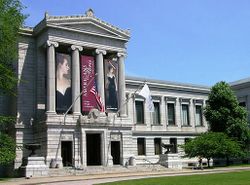 |
|
| Established | 1870 |
| Location | 465 Huntington Avenue, Boston, Massachusetts 02115 |
| Visitor figures | Over 1 million visits annually |
| Director | Malcolm Rogers |
| President | George T. M. Shackelford |
| Website | www.mfa.org |
The Museum of Fine Arts in Boston, Massachusetts, is one of the largest museums in the United States, attracting over one million visitors a year. It contains over 450,000 works of art, making it one of the most comprehensive collections in the Americas.
The museum was founded in 1870 and its current location dates to 1909. In addition to its curatorial undertakings, the museum is affiliated with an art academy, the School of the Museum of Fine Arts, and a sister museum, the Nagoya/Boston Museum of Fine Arts, in Nagoya, Japan. The current director of the museum is Malcolm Rogers.
Contents |
History
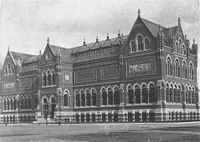
1870-1909
The Museum was founded in 1870 and opened in 1876, with a large portion of its collection taken from the Boston Athenaeum Art Gallery. Francis Davis Millet was instrumental in starting the Art School attached to the Museum and getting Emil Otto Grundmann (1844 - 1890) appointed as its first director.[1]
Originally located in a highly ornamented brick Gothic Revival building designed by John Hubbard Sturgis and Charles Brigham, located on Copley Square in the Back Bay neighborhood of Boston. The Copley Square building was notable for its large-scale use of architectural terra cotta in the United States. The Museum moved to its current building on Huntington Avenue, Boston's "Avenue of the Arts," in 1909.
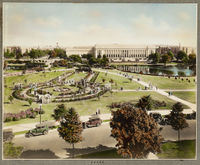
1909-2000s
The museum's present building was commenced in 1907, when museum trustees hired architect Guy Lowell to create a master plan for a museum that could be built in stages as funding was obtained for each phase. The first section of Lowell’s neoclassical design was completed in 1909, and featured a 500-foot (150 m) façade of cut granite along Huntington Avenue, the grand rotunda, and the associated exhibition galleries. Mrs. Robert Dawson Evans then funded the entire cost of building the next section of the museum’s master plan. This wing along the Back Bay Fens, opened in 1915 and houses painting galleries. From 1916 through 1925, John Singer Sargent created the art that lines the rotunda and the associated colonnade. Numerous additions enlarged the building throughout the years including the Decorative Arts Wing in 1968 and the Norman Jean Calderwood Garden Court and Terrace in 1997. This wing now houses the museum's cafe, restaurant, and gift shop as well as exhibition space.
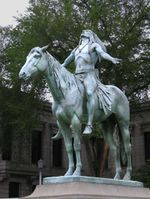
The libraries at the Museum of Fine Arts house an extensive collection of 320,000 items. The William Morris Hunt Memorial Library is named in honor of the Vermont native and Boston painter and arts teacher, many of whose works are in the museum's permanent collection.[2] Among the museum's holdings of Hunt's canvases is the 1866 Italian Peasant Boy.[3]
2000s expansion
In the mid-2000s, the museum embarked on a major renovation project. This includes the construction of a new wing for the arts of the Americas, redesigned and expanded education facilities, and extensive renovations of its European galleries, visitor services, and conservation facilities. This expansion will increase the size of the MFA by 28% with an additional 133,500 square feet (12,400 m2) of space.[4]
The new wing was designed in a restrained, contemporary style by the London architectural firm of Foster and Partners, under the directorship of Thomas T. Difraia. Groundbreaking for the addition took place in 2006; CBT Architects of Boston was the Architect of Record. In the process, the present garden courtyard will be transformed into a climate-controlled year-round glass enclosure. Landscape architects Gustafson Guthrie Nichol have redesigned the Huntington Avenue and Fenway entrances, gardens, access roads, and interior courtyards. The opening of the new wing is scheduled for late 2010.[4]
Collection and exhibits
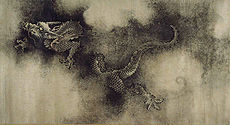
Some highlights of the MFA's collection include:
- Egyptian artifacts including sculptures, sarcophagi, and jewelry.
- French impressionist and post-impressionist works including Paul Gauguin's Where Do We Come From? What Are We? Where Are We Going? (D'où venons-nous? Que sommes-nous? Où allons-nous?) as well as works by Manet, Renoir, Degas, Monet, Van Gogh, Cézanne and many others.
- 18th and 19th century American art, including many works by John Singleton Copley, Winslow Homer and John Singer Sargent.
- Extensive collection of Chinese painting, calligraphy and imperial Chinese art, including some of the most treasured paintings in Chinese history
- The largest museum collection of Japanese works under one roof in the world outside of Japan, including the Edward S. Morse collection of 5,000 pieces of Japanese pottery.
- the Gund Gallery which hosts temporary exhibits while a Japanese garden provides a quiet, contemplative space outside the museum itself.
More Collection Highlights
- Art of Asia, Oceania, and Africa
- Art of Europe
- Art of the Americas
- Art of the Ancient World
- Contemporary Art
- Musical instruments
- Prints, Drawings, and Photographs
- Textile and Fashion Arts[5]
 Egyptian room in former museum building, Copley Square, 19th c. |
 Medieval room in former museum building, Copley Square, 19th c. |
Paul Gauguin's Where Do We Come From? What Are We? Where Are We Going? (D'où venons-nous? Que sommes-nous? Où allons-nous?) (1897) |
 The Museum of Fine Arts is renowned for its collection of artifacts from ancient Egypt (this exhibit was used on Reading Rainbow's fifty-fourth episode "Mummies Made In Egypt", based on the book by Aliki on March 30, 1989) |
 King Mycerinus (Menkaura) and his queen |
 European Paintings and Sculptures at the Boston Museum of Fine Arts |
Former museum building, Copley Square, Boston, 19th c. |
 Niagara Falls, William Morris Hunt, c. 1878 |
The Museum also maintains one of the largest on-line art catalogs in the world at http://www.mfa.org, with information about over 346,000 items from its collection available on-line, many with an accompanying photograph.
As a result of the ongoing expansion of the museum, a number of standing exhibits are still in storage.
Notable Curators
- Sylvester Rosa Koehler (1837-1900) First Curator of Prints
- Fitzroy Carrington (born 1869) Curator of prints
- William George Constable (1887-1976), Curator
- Ernest Fenollosa (1853-1908) - Curator of Oriental Art (1890-1896)
- Okakura Kakuzō (1863-1913) - Curator of Oriental Art (1904-1913)
- Ananda Coomaraswamy (1877-1947) - Curator of Oriental Art
- Robert Treat Paine (d. 1965) - Curator of Japanese Art (1963-1965)
- Anne Nishimura Morse (1956-present)-William and Helen Pounds Senior Curator of Japanese Art (1985-present)
Notable Directors
George Peabody Gardner
Visiting
Admission to the museum is charged at most times, but there is free admission on Wednesdays after 4 p.m. The Museum is open until 9:45 p.m. on Wednesdays, Thursdays and Fridays. The museum's University Membership program offers area college students free general admission and discounts on special exhibits upon presentation of a valid college photo ID.
See also
- School of the Museum of Fine Arts, Boston
- Nagoya/Boston Museum of Fine Arts
References
- ↑ John Singer Sargent Virtual Gallery
- ↑ The William Morris Hunt Memorial Library, Museum of Fine Arts, Boston, mfa.org
- ↑ Italian Peasant Boy, 1866, permanent collection, Museum of Fine Arts, Boston, gift of George Peabody Gardner, mfa.org
- ↑ 4.0 4.1 A Museum Expansion Fact Sheet
- ↑ Museum of Fine Arts, Boston: About, ARTINFO, 2008, http://www.artinfo.com/galleryguide/18868/5428/about/museum-of-fine-arts-boston-boston/, retrieved 2008-07-29